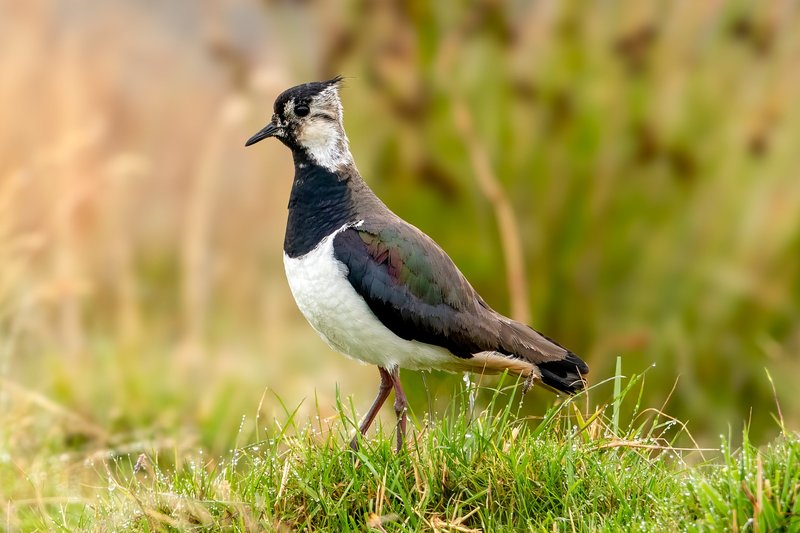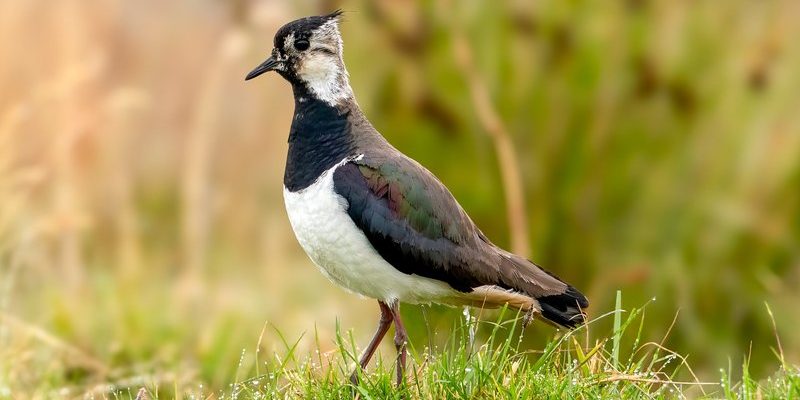
The Northern Lapwing is a striking bird that often captures the attention of anyone lucky enough to spot it. With its distinctive crest, vibrant plumage, and unique behaviors, this shorebird is more than just a pretty face. Imagine a bird that seems to dance as it flies, weaving gracefully through the sky while emitting a joyful call. That’s the Northern Lapwing for you, embodying a captivating charm that makes it a favorite among birdwatchers and nature enthusiasts alike.
You might be wondering what sets this bird apart from others. Well, the Northern Lapwing is not just another avian resident; it has a rich history and a significant role in its ecosystem. These birds thrive in open fields and wetlands across Europe and parts of Asia, showcasing their adaptability and resilience. As we delve deeper into the world of the Northern Lapwing, we’ll uncover their fascinating traits, habitats, and the challenges they face today.
Physical Characteristics of the Northern Lapwing
The Northern Lapwing is easily recognized by its unique physical features. Typically, adults measure approximately 28-32 cm in length, boasting a wingspan that can reach up to 80 cm. Their feathers are a blend of glossy greens, browns, and whites, with a striking black crown and a distinctive crest that adds to their character. When in flight, their broad wings reveal a white stripe that contrasts beautifully against the dark plumage.
One of the most endearing traits of the Northern Lapwing is their enchanting courtship display. The males are known for their aerial acrobatics, soaring high and performing elegant dives while calling out to attract a mate. It’s a spectacle that showcases not only their physical prowess but also their vibrant personalities. Isn’t that fascinating? They really know how to woo their partners!
Their long, slender legs are perfectly adapted for their habitat, allowing them to wade in shallow waters and traverse marshy fields with ease. A keen observer might even notice the distinct white “V” on their back when they spread their wings, a signature marking that makes them stand out in the landscape.
| Characteristic | Description |
| Size | 28-32 cm in length |
| Wingspan | Up to 80 cm |
| Habitat | Open fields, wetlands, and pastures |
| Diet | Insects, larvae, and seeds |
| Coloration | Black crown, green and brown plumage |
| Lifespan | Typically up to 10 years |
Habitat and Distribution
So, where does the Northern Lapwing call home? These birds prefer open, grassy areas, wetlands, and agricultural fields where they can forage for food and raise their young. You’ll find them across Europe and parts of Asia, often in areas with plenty of water bodies. They are particularly fond of regions that have a mix of cultivated land and natural wetlands, creating an ideal environment for their lifestyle.
The Northern Lapwing migrates seasonally, with populations in northern Europe heading south to spend the winter in milder climates. They can often be spotted in large flocks during migration, creating an awe-inspiring sight as they travel together in search of food and warmth. Their migratory habits are influenced by factors like temperature and food availability, making adaptability a key part of their survival.
However, the Northern Lapwing’s habitat is under threat due to agricultural intensification, urbanization, and climate change. Wetlands are drained for farming, and natural grasslands are converted into urban spaces, reducing the places where these birds can thrive. Conservation efforts are crucial in ensuring that future generations can appreciate the beauty of the Northern Lapwing in their natural environment.
Diet and Feeding Habits
The Northern Lapwing is an omnivorous bird, which means it has a varied diet that includes a wide range of foods. Their diet primarily consists of insects, worms, and larvae, which they find by probing the ground with their long, slender beaks. This behavior is quite remarkable to witness; it’s like watching a little digger at work, searching for its next meal beneath the surface.
Aside from invertebrates, Northern Lapwings also eat seeds and plant matter, especially during the breeding season when they require extra energy to care for their young. During the spring, you might see them congregating in fields, feasting on the insects that emerge with the warmer weather. It’s a vital part of their feeding strategy, allowing them to gain the necessary nutrients for reproduction and survival.
Interestingly, the way they feed can vary depending on the season and conditions. In wetter periods, they often feed in shallow water, while in drier times, they’ll scavenge in open fields. Their adaptability in foraging strategies provides them with the versatility needed to thrive in changing environments.
Breeding and Nesting Behavior
Breeding season for the Northern Lapwing is a spectacular time, filled with courtship displays and the sounds of chirping chicks. Typically, they begin nesting in early spring, choosing a concealed location in tall grass or near water. The female lays 3-4 eggs, which are well-camouflaged among the surrounding vegetation. This clever strategy helps protect the eggs from potential predators.
During the incubation period, both parents take turns keeping the eggs warm. This shared responsibility is a wonderful aspect of their breeding behavior, ensuring that the eggs are cared for around the clock. When the chicks finally hatch, they are precocial, meaning they are able to walk and feed themselves shortly after birth. This independent nature is crucial for their survival, especially in the wild.
Parenting doesn’t stop there, though. The adults remain vigilant, guiding their chicks to suitable feeding grounds and teaching them essential survival skills. However, raising young Northern Lapwings comes with challenges, as their nests are often threatened by human activities, such as farming and habitat destruction. Conservation efforts to protect nesting sites are crucial for ensuring the future of these charming birds.
Challenges and Conservation
The Northern Lapwing faces a variety of challenges in today’s world. Habitat loss is perhaps the most significant threat, as wetlands and grasslands are drained or converted for agriculture and urban development. This not only reduces their nesting sites but also affects the availability of food sources. Can you imagine being a bird that once thrived in a lush field, only to find it replaced by a concrete jungle?
Additionally, climate change poses a threat by altering weather patterns and affecting the timing of migration and breeding. As temperatures rise, Northern Lapwings may find it challenging to locate suitable habitats or food sources. Migrating birds often rely on specific environmental cues, and any disruption to these patterns can lead to disastrous consequences.
Conservation efforts are essential to protect the Northern Lapwing and its habitat. Initiatives aimed at preserving wetlands, promoting sustainable farming practices, and raising awareness about the importance of these birds can make a significant difference. By participating in local conservation programs or simply spreading the word about their plight, you can help ensure the future of this majestic shorebird.
FAQ
What is the Northern Lapwing’s scientific name?
The scientific name of the Northern Lapwing is Vanellus vanellus. This name reflects its classification in the family of birds known as the waders or shorebirds, which are known for their long legs and beaks adapted for foraging.
How can I identify a Northern Lapwing in the wild?
Identifying a Northern Lapwing is quite easy with its unique features. Look for its distinctive crest, black and white coloration, and the striking white wing stripe seen in flight. Their playful, agile movements and cheerful calls are also tell-tale signs that you’re in the presence of these charming birds.
Are Northern Lapwings migratory birds?
Yes, Northern Lapwings are migratory birds. They migrate to warmer regions in the winter, typically moving south from their breeding grounds in northern Europe. During migration, they often travel in large flocks, creating an uplifting spectacle in the sky.
What do Northern Lapwings eat?
Northern Lapwings primarily feed on insects, worms, and larvae, as well as seeds and plant matter. Their feeding habits change with the seasons, often foraging in wetland areas during wetter periods and in open fields when it’s drier. This dietary versatility helps them thrive in various conditions.
How long do Northern Lapwings typically live?
Northern Lapwings can live up to 10 years in the wild, although their lifespan may be affected by environmental factors, predation, and habitat loss. The combination of these challenges can significantly impact their life expectancy.
What conservation efforts are being made for the Northern Lapwing?
Conservation efforts for the Northern Lapwing focus on habitat preservation and encouraging sustainable farming practices. Initiatives include protecting wetlands and grasslands, creating awareness about the species’ plight, and supporting programs aimed at mitigating the impact of climate change on their habitats.
Can I help protect Northern Lapwings in my area?
Absolutely! You can help protect Northern Lapwings by supporting local conservation programs, participating in habitat restoration projects, and educating others about these remarkable birds. Simple actions, like avoiding disturbing nesting sites and promoting wildlife-friendly practices, can also make a significant impact in your community.
What is the breeding behavior of Northern Lapwings?
Northern Lapwings typically lay 3-4 eggs in well-concealed nests located in tall grass or near water. Both parents share incubation and care responsibilities, ensuring that the eggs are safe and warm. After hatching, the chicks are precocial and quickly learn to forage for food.
Are Northern Lapwings social birds?
Yes, Northern Lapwings are quite social, especially outside the breeding season. They often gather in large flocks during migration and can be seen foraging in groups. This social behavior can be beneficial for locating food and providing protection from predators.
What are the threats to Northern Lapwing populations?
The primary threats to Northern Lapwing populations include habitat loss due to agricultural expansion, urbanization, and climate change. These factors can lead to reduced nesting sites and food availability, putting additional pressure on already vulnerable populations.
Do Northern Lapwings have any natural predators?
Yes, Northern Lapwings can fall prey to various predators, including foxes, raptors, and even larger birds, especially during the nesting season. Their camouflaged eggs and chicks are at risk, making it crucial for parents to be vigilant in protecting their young.
How can I observe Northern Lapwings responsibly?
To observe Northern Lapwings responsibly, it’s essential to keep a respectful distance, especially during breeding season when they’re nesting. Use binoculars for a closer look without disturbing them. Avoid walking through nesting areas and follow local guidelines for wildlife observation to minimize your impact on their habitat.

